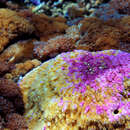Biology
provided by World Register of Marine Species
zooxanthellate
van der Land, J. (ed). (2008). UNESCO-IOC Register of Marine Organisms (URMO).
- license
- cc-by-4.0
- copyright
- WoRMS Editorial Board
Description
provided by World Register of Marine Species
A free living, colonial fungiid, which can reach 75 cm tall and broad. Small colonies up to 20 cm across are usually flat, but larger colonies become increasingly dome shaped, developing into regular or irregular, hollow hemispheres. The colour photo is the edge of a rim of a large, domed specimen. Corallites are numerous, and all of the same size, (though a larger central one can sometimes be found at the top of the dome or in the centre of the disk). Septa run discontinuously down the sides, and are usually very sharp. Colonies are brown to cream, usually with a purple rim. (Sheppard, 1998 ) Colonies are large and free-living, circular, dome- or bell-shaped, thin and delicate and without an axial furrow. Corallites are widely spaced. Septo-costae are similar to those of Fungia fungites. Polyps are extended only at night. Tentacles are small and widely spaced. Colour: pale brown, frequently with bright-pink or purple margins. Abundance: occurs on middle to lower reef slopes in lagoons on soft substrates. Usually uncommon. (Veron, 1986 ) Unmistakable; free-living, dome or bell-shaped colonies to 50 cm in height and diameter. Corallites evenly spaced over the entire colony. Colour: brownish-orange with pink to purple lower rim. Habitat: shallow reefs. (Richmond, 1997)
Roux, J.P. (2001) Conspectus of Southern African Pteridophyta. Southern African Botanical Diversity Network Report 13 Page 118 (Includes a picture).
- license
- cc-by-4.0
- copyright
- WoRMS Editorial Board

